Plum trees are an attractive addition to any garden and a delicious summer treat. Even better, they’re very easy to grow and produce vast quantities of fruit. Whether you choose sweet varieties for eating or sour varieties for cooking, here are some of the best articles, videos and Instagram posts to help you successfully grow and harvest your own plums.
Browse our full range of plum trees to find traditional favourites and exciting new grafted cultivars.
Contents:
- Best expert advice on planting plum trees
- Best advice on growing plum trees in containers
- Best expert advice on training and pruning plum trees
- Best expert advice on plum varieties to try
Best expert advice on planting plum trees
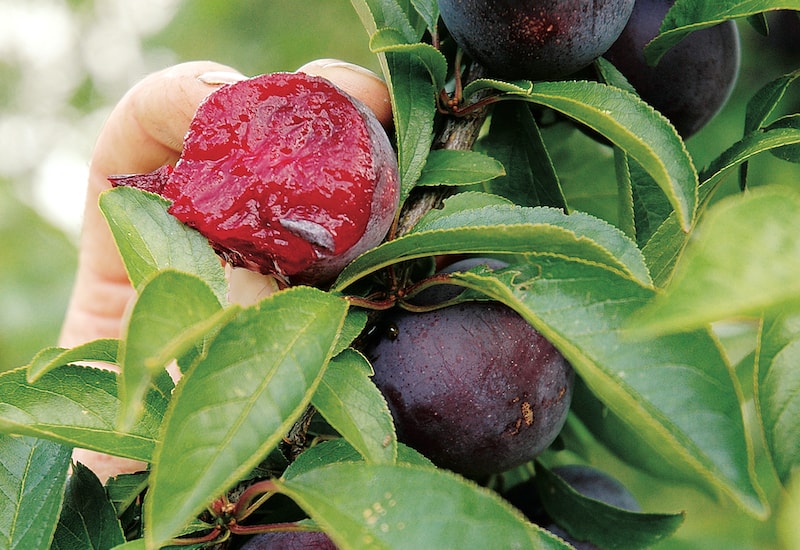
Image: Plum Tree – Beauty from Suttons
Plum trees should be planted in a sunny, sheltered spot, says the horticultural team at Suttons. “If you’re looking for a variety suitable for a cool corner, try a hardy damson which can cope with lower temperatures,” they recommend. And if you’re lucky enough to have a really bright, south-spacing spot, try greengages for exceptionally sweet, flavoursome fruits. Read the full article for lots of practical tips on planting plums.
Over at @worminsterfarm, Peter and Pip planted more than 30 fruit trees in their new orchard. Because they chose bare root trees, they needed to plant them in winter while they’re still dormant, and added a “top up of good soil and some root powder to help them on their way.” In their helpful post, they recommend staking your fruit trees to protect them from high winds. Take a look at the step-by-step photos, including the beautiful avenue of plum trees that flanks their newly-planted space!
“If you think you’re only going to have the odd plum, think again!” says Paulo over at his excellent YouTube channel Paulo The Urban Gardener. To be sure of a prolific harvest, he grows two plum trees to help lots of fruit to set – the popular ‘Victoria’ and a Cherry Plum that he says would also make a fantastic edible hedge. Watch Paulo’s video to see how quickly his tiny whips grow into fruiting trees. It’s amazing how fast they develop!
Best advice on growing plum trees in containers
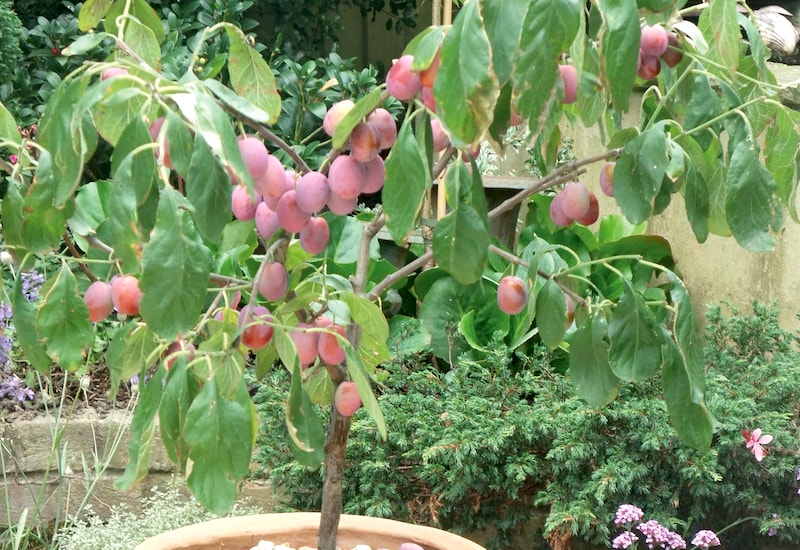
Image: Plum (Prunus) Victoria Patio Standard (St Julien) from Suttons
“Having a small garden doesn’t mean you have to be without,” says Peppe who grows seven types of plum tree so he can enjoy eating his favourite fruit at different times of the year. “They can easily be grown…in large containers.” Peppe looks for a dwarf rootstock when choosing plum trees for pots. But even if you don’t get fruit, he says that plum trees are worth growing for their gorgeous spring flowers alone. Follow him at @pepgrows for lots of plum-growing wisdom.
If you only have space for one tree, a plum makes a fantastic choice, says Mel from @melslittlegarden. She chose a Victoria plum for her container garden because it’s “easy to grow and a reliable cropper”. She went for a smaller variety that will only grow to 3m tall – perfect for a large pot. And the good news is that it’s self-fertile, meaning that it “will fruit without a pollination partner”. Follow her on Insta to see how she gets on.
If you grow plum trees in containers, “you have to water them A LOT” warns Susy from @susybliving. In warm weather, you’ll need to check the soil regularly and she also recommends feeding them for the best results. “When they’re in fruit I like to use a high potash feed like a tomato food,” she says. Susy repotted her grafted plum tree at the beginning of spring and is keeping her fingers crossed for a good crop. With five different varieties grafted onto one stem, she’s unlikely to get bored in a glut!
When winter arrives, container fruit trees need a little more care than their in-ground cousins. Over at Allotment & Gardens, John Harrison recommends bringing your potted plum trees under cover so they have an uninterrupted period of dormancy. “The back of an unheated garage would be ideal or a shed may be enough if it doesn’t get too cold.” Why is this a good idea? John explains that container soil can heat up on sunny winter days “and fools the tree into acting as if spring has arrived.” Then, when the temperature drops again, the tree is unable to use the sugars it has produced and eventually dies. Read John’s full article for more advice.
Best expert advice on training and pruning plum trees
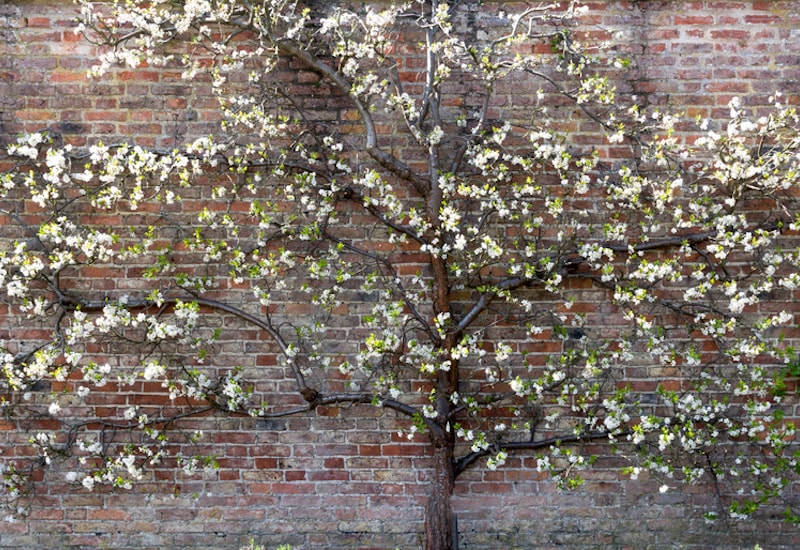
Image: Shutterstock
“Plum trees can be trained to grow in a variety of shapes, such as bush, pyramid, fan or standard,” says Georgina from Let’s Grow Wild. Just choose the right size and rootstock for the particular shape you want to achieve, she adds. If you have a small garden, try a fan shape, “which is when the branches are trained to grow laterally…against a wall or on wires.” This method saves precious space while still giving you “a decent yield of sweet, juicy plums” in late summer.
If you’re growing a natural-looking, bush-shaped plum tree, you can prune from April, says Joel from @thegoodsoilgardener, “although older trees usually benefit from pruning in summer.” Plums are one of the most forgiving of fruit trees: “you essentially leave the tree to grow as it wishes and then in April you remove crossing branches as well as any that are diseased, weak or damaged.” Joel’s excellent post explains that the aim is to create an open-centred tree that’s not overcrowded. “It can be thinned more in July if needed,” he adds.
Over at Laing Landscape Design, professional gardener Karen prefers to prune plum trees between June and August to avoid the chance of silver leaf disease. Plum trees that are trained against a wall often crop more heavily, as they benefit from extra warmth and shelter. Because of this, you need to maintain a strong support structure when pruning, she says. Watch her helpful video for a practical guide.
Swipe through Tanya’s photos at @lovely.greens to see how much she took off her plum tree when it succumbed to plum pocket. The drastic August prune made her a bit nervous, but by taking the height off her plum tree she’ll be able to “better reach and treat it next spring”. Follow Tanya on Instagram to see what happens!
Best plum varieties to grow
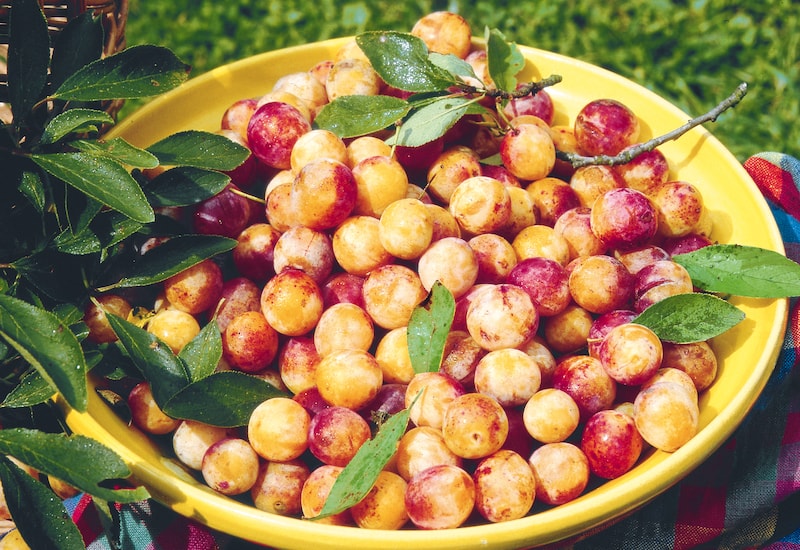
Image: Mirabelle Tree – de Nancy from Suttons
Esther adores her Victoria plum tree, but says that all varieties are a winner. What’s not to love about “heavy crops of fruit in late summer and pretty blossom in early spring, which attracts bees and other pollinators to its sweet nectar”? Visit @esthersgardening to sneak a peek at her beautifully trained plum tree growing against a fence. In full blossom, it’s a sight to behold!
Hannah from @gingergrows1 has two plum trees – a Victoria and a Damson. She says, “we got them as grafted bare roots 4 seasons ago and they’ve produced prolifically for the past 3 years!” Not only have they been quick to yield fruit, her trees are already producing vast quantities of it. Hannah says, “I harvested over 150 plums off the Victoria tree and there’s still a harvest to be had off the Damson.” See her Insta photos of the bumper crop.
Over at @plottygrow, Plotty has a huge fondness for greengages. She says that “these sweet plums make a delicious jam or tart and are often best simply ripe from the tree.” While they remind Plotty of her very British childhood, she explains that these exotic little fruits actually “originate from a wild plum tree in Iran.” Read her fascinating post to find out how they got their name.
Peppe pays homage to “one of the most beautiful plums, Mirabelle De Nancy,” in his full Insta guide to this popular stone fruit over at @pepgrows. Looking back over the 2020 growing season, he has stitched together a fantastic series of seven posts that tell the entire story of growing his favourite bright yellow plum in a container in a tiny garden. The proof is in the pudding, as they say, and he says his delicious little plums are just as good when eaten “fresh, baked, blended or stewed”.
We hope this has given you plenty of insight into growing plums, whether you choose a patio variety, train your tree against a wall, or plant it in the ground. Even if you leave the fruits for local wildlife to enjoy, a plum tree is worth growing for its beautiful blossom alone! Browse our full range of fruit trees for more ornamental edible ideas.
Lead image: Plum (Prunus) Herman from Suttons
Last Updated on September 5, 2024 by Suttons Horticultural Team

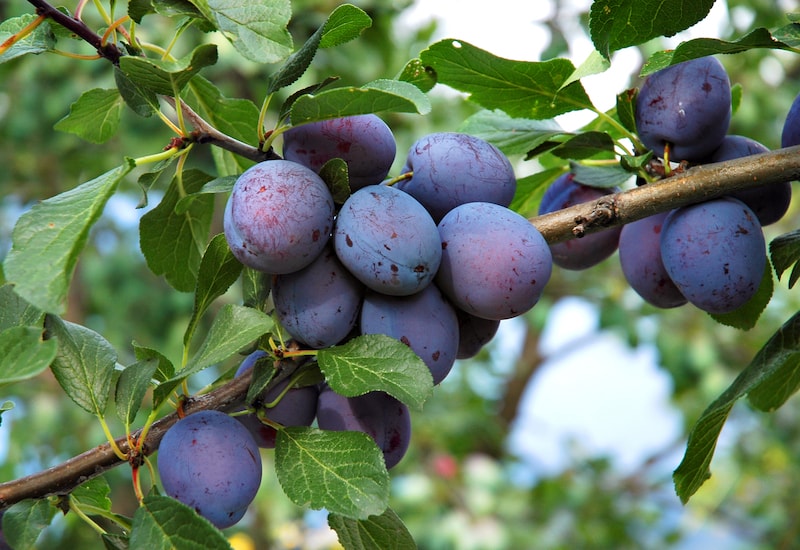




I have 2 plums, one greengage and an apricot tree all 4 years old supposed to be on dwarf rootstock but are all 4-5 metres high and are all within 12 metres of each other in a windy, south facing small garden. Problem! Have no crops at all as pigeons eat emerging leaves and flowers. They’re all too tall to net and have tried scaring with ultrasonic, tinsel, windmills and CD discs but nothing has worked. Any idea what will?